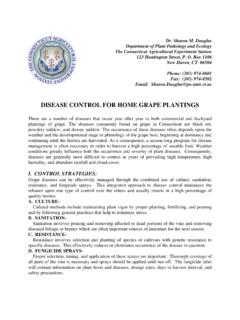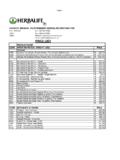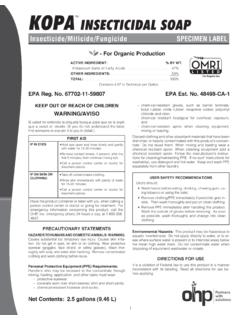Transcription of Woody Vines-Identification and Control
1 Dr. Jatinder S. Aulakh Valley Laboratory, Windsor, CT. The connecticut Agricultural Experiment Station 153 Cook Hill Road, P. O. Box 248. Windsor, CT 06095. Phone: (860) 683-4984. Fax: (860) 683-4987. Founded in 1875 Email: Putting science to work for society Website: Woody Vines-Identification and Control Oriental Bittersweet Scientific Name: Celastrus orbiculatus Thunb. Porcelain Berry/Amur Peppervine Scientific Name: Ampelopsis GENERAL DESCRIPTION: A non- brevipedunculata (Maxim.) Trautv. native, deciduous, perennial Woody vine that twines around and climbs up trees and shrubs.
2 It grows very aggressively and can reach up to 60 feet tall. Leaves are simple, alternate, elliptic-to-round in shape with slightly toothed margins. Flowers are yellow in color, borne in axillary dangling clusters. Mature fruit capsules are yellow in color containing bright red berries inside. Oriental bittersweet colonizes by vegetative GENERAL DESCRIPTION: A non- sprouting from roots and spreads to new native, deciduous, perennial Woody vine locations through seed dispersal by birds, that can grow up to 20 feet tall. It is highly animals, and humans.
3 Its native counterpart, invasive in the eastern United States. Leaves the American bittersweet (Celastrus are heart-shaped and may have entire, scandens L.), has terminal white flower toothed, or symmetrically lobed margins. clusters and orange fruit capsules. The two Vines can climb over shrubs, trees, and rock species are cross compatible can easily faces with the help of clinging forked hybridize. tendrils. Flowers are inconspicuous, yellowish in color, and borne in small clusters. Fruits are spherical multicolored berries of white, green, and blue color.
4 M Leaves are alternate, simple, glossy and dark green with pale or whitish veins. Leaf shape Porcelain berry colonizes by a prolific varies with age of the vine ; leaves of network of vines that root at nodes and juvenile plants are three to five lobed and spreads to new locations by water, birds, and those of mature plants are lanceolate and possibly, animals. It can be distinguished without lobes. Flowers are greenish-yellow from its native counterpart, the heartleaf in color and are produced on mature vines, peppervine (Ampelopsis cordata Michx.)
5 Ten years or older. Mature berry-like fruits, which has unlobed leaves and hairless called drupes, are dark blue to purple in stems. color. Juvenile vines multiply vegetatively from stem and root fragments. Mature vines English Ivy may also reproduce via seeds. English ivy Scientific Name: Hedera helix L. colonizes by trailing and climbing vines that root at nodes. Seeds are consumed by birds that are a vector of dispersal into new areas. English ivy is toxic to humans if eaten and even touching it can trigger dermatitis in sensitive individuals.
6 Non-native Wisterias: Chinese Wisteria [Wisteria sinensis (Sims). DC.] and Japanese Wisteria [Wisteria floribunda (Willd) DC.]. GENERAL DESCRIPTION: A non- native, evergreen vine commonly seen climbing up trees, buildings and other structures. Some of the older vines have measured over 90 feet in length and 1 foot in stem diameter. Woody vine - identification and Control Jatinder Aulakh The connecticut Agricultural Experiment Station ( ). legume pod, velvety hairy, and greenish brown to golden in color. Both wisterias colonize by vines that root at nodes and spread to new locations by humans or as water-dispersed seeds along riparian areas.
7 Non-native wisterias can be distinguished from their native counterpart, the American wisteria [Wisteria frutescens (L.) Poir.], which flowers in June-August, whereas the GENERAL DESCRIPTION: Non-native, non-native wisteria flower in March-May. deciduous, climbing and twining, perennial, leguminous Woody vines that can grow up to Poison Ivy 70 feet tall. Leaves are alternate, pinnately Scientific Name: Toxicodendron radicans compound. Leaflets are oppositely arranged L. and vary in numbers from 7 to 13 in Chinese wisteria or 13 to 19 in Japanese wisteria.
8 Flowers are fragrant and arranged in dangling, showy clusters called racemes. GENERAL DESCRIPTION: A native, Woody vine that may grow as a dwarf, shrubby plant or a prostrate trailer carpeting the ground but usually it is seen climbing trees or other objects. Leaves are alternately arranged on stems, compound with three leaflets, and have smooth, toothed or lobed edges. In contrast, Virginia creeper, a non- poisonous, poison ivy-look-like, has five In Chinese wisteria, all flowers in a raceme leaflets. Newly produced leaves are an bloom at about the same time whereas in interesting reddish color which turn shiny Japanese wisteria blooming proceeds green as they mature.
9 Leaf surfaces may be gradually from the base upwards. Another glossy or dull with sparse hair on the lower difference between the two is that the surface. Yellowish-green flowers (June- Chinese wisteria vines spiral clockwise July) are produced in clusters originating while the Japanese wisteria vines spiral in a from the leaf axil. The clusters of small, counterclockwise direction. Nevertheless, round, waxy, berry-like white fruit appear in the two species are often difficult to late summer and often persist all winter. distinguish due to possible hybridization.
10 Poison ivy propagates by underground Fruit is a flattened, oblong to oblanceolate rhizomes and seeds. Woody vine - identification and Control Jatinder Aulakh The connecticut Agricultural Experiment Station ( ). by means of tendrils. Leaves are alternate, palmately compound with five leaflets. Leaves are bright green above and pale green below and turn into a regaling red color in fall. The leaflets have jagged margins. Seeds are eaten by birds and other animals which help in its further spread. Poison ivy is a well-known human health hazard.
















